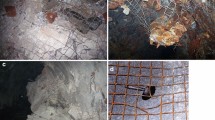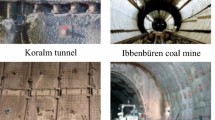Abstract
Ground support in underground excavations is typically comprised of surface support and rock reinforcement elements. The performance of a ground control system is controlled to a large degree by the interaction between reinforcement and surface support elements. There is significantly less information on the behaviour of surface support compared to rock reinforcement under load. The main source of technical information is through laboratory testing. These investigations however are not standardised and only provide information for limited testing configurations. In this respect, numerical modelling can be used as a complementary and in many cases more robust approach to look at mesh performance under different loading conditions. A prerequisite for this approach is to demonstrate the ability to successfully emulate the mechanical behaviour of bolted wire mesh using numerical models. This paper reports on numerical experiments aiming to reproduce the observed behaviour of bolted welded wire mesh in well documented laboratory tests. The distinct element method was used to construct a series of 3D numerical models to investigate the influence of bolting pattern on the performance of mesh. The developed models successfully captured the load, displacement, and failure of welded wire mesh of multiple wire diameters and demonstrated the impact of the bolting pattern on the loading characteristics and deformation of welded wire mesh. This provides confidence in using the developed numerical tools to further investigate the impact of bolting patterns on the mechanical behaviour of mesh. This would result in valuable information for the optimization of ground support strategies in underground excavations.
















Similar content being viewed by others
References
Bertrand D, Nicot F, Gotteland P, Lambert S (2008) Discrete element method (DEM) numerical modelling of double-twisted hexagonal mesh. Can Geotech J 45(8):1104–1117
Coates DF (1981) Rock mechanics principles: energy, mines and resources. Mines Branch, Government of Canada, Ottawa
Gadde M, Rusnak J, Honse J (2006) Behaviour of welded wire mesh used for skin control in underground coal mines. In: Peng S (ed) Proceedings of the 25th international conference on ground control in mining. National Institute for Occupational Safety and Health, pp 142–151
Grimstad E, Barton N (1993) Updating the Q-system for NMT. In: Kompen C, Opsahl SL, Berg SL (eds) Proceedings of the international symposium on sprayed concrete, Norwegian Concrete Association, p 21
Hadjigeorgiou J (2016) Rock support: degradation and failure. In: Nordlund E, Jones T, Eitzenberger A (eds) Ground support 2016: 8th international symposium on ground support in mining and underground construction. Luleå, Sweden, pp 1–21
Hadjigeorgiou J, Stacey TR (2018) Challenges in determining the capacity of mesh. In: Proceedings of the Fourth Australasian Ground Control in Mining Conference, Sydney, pp 280–290
Hadjigeorgiou J, Tomasone P (2018) Characterising the behaviour of rockbolts based on in situ pull tests. In: Potvin Y, Jakubec J (eds) Proceedings of the fourth international symposium on block and sublevel caving. Australian Centre for Geomechanics, Perth, pp 727–734
Itasca Consulting Group Inc. (2012) FLAC3D: fast Lagrangian analysis of continua, version 5.0, Itasca Consulting Group Inc., Minneapolis
Itasca Consulting Group Inc (2016a) 3DEC-three-dimensional distinct element code, 5.2 edn. Itasca Consulting Group Inc, Minneapolis
Itasca Consulting Group Inc (2016b) 3DEC-theory and background. Itasca Consulting Group Inc, Minneapolis
Karampinos E, Hadjigeorgiou J, Turcotte P (2016) Discrete element modelling of the influence of reinforcement in structurally controlled squeezing mechanisms in a hard rock mine. Rock Mech Rock Eng 49(12):4869–4892
Karampinos E, Baek B, Hadjigeorgiou J (2018) Discrete element modelling of a laboratory static test on welded wire mesh. In: Potvin Y, Jakubec J (eds) Proceedings of the fourth international symposium on block and sublevel caving. Australian Centre for Geomechanics, Perth, pp 735–746
Li CC, Stjern G, Myrvang A (2014) A review on the performance of conventional and energy-absorbing rockbolts. J Rock Mech Geotech Eng 6(4):315–327
Lorig L, Varona P (2013) Guidelines for numerical modelling of rock support for mines. In: Potvin Y, Brady B (eds) Proceedings of the seventh international symposium on ground support in mining and underground construction. Perth, pp 81–105
Morton E, Thompson A, Villaescusa E, Roth A (2007) Testing and analysis of steel wire mesh for mining applications of rock surface support. In: Proceedings of the 11th congress of the international society for rock mechanics. Lisbon, pp 1061–1064
Potvin Y, Hadjigeorgiou J (2016) Selection of ground support for mining drives based on the Q-system. In: Nordlund E, Jones TH, Eitzenberger A (eds) Proceedings of the 8th international symposium on ground support in mining and underground construction, pp 1–16
Roth, A, Cala, M, Brändle, R, Rorem E (2014) Analysis and numerical modelling of dynamic ground support based on instrumented full scale tests. In: Hudyma M, Potvin Y (eds), Proceedings of the seventh international conference on deep and high stress mining, Australian Centre for Geomechanics, Perth, pp 151–164
Shan Z, Porter I, Nemcik J (2014) Performance of full scale welded steel mesh for surface control in underground coal mines. In: Morsi BI (ed) Proceedings of the 31st annual international pittsburgh coal conference: coal—energy, environment and sustainable development, vol 1, International Pittsburgh Coal Conference, University of Pittsburgh, Pittsburgh, pp 1–10
Tannant D (1995) Load capacity and stiffness of welded-wire mesh. In: Proceedings of the 48th Canadian geotechnical conference, Vancouver, pp 729–736
Thoeni K, Giacomini A, Lambert C, Sloan SW, Carter JP (2014) A 3D discrete element modelling approach for rockfall analysis with drapery systems. Int J Rock Mech Min Sci 68:107–119
Thompson A (2004) Rock support action of mesh quantified by testing and analysis In: Potvin Y, Stacey T, Hadjigeorgiou J (eds) Surface support in mining. Australian Centre for Geomechanics, Nedlands, Western Australia, pp 391–398
Xu C, Tannant D, Zheng W (2019) Discrete element analysis of the influence of bolt pattern and spacing on the force-displacement response of bolted steel mesh. Int J Numer Anal Methods Geomech 43(12):2106–2125. https://doi.org/10.1002/nag.2974
Xu C, Tannant D, Zheng W, Liu K (2020) Discrete element method and support vector machine applied to the analysis of steel mesh pinned by rockbolts. Int J Rock Mech Min Sci 125:104163. https://doi.org/10.1016/j.ijrmms.2019.104163
Acknowledgements
The authors acknowledge the financial support of the Natural Sciences and Engineering Research Council of Canada. The technical input of Jim Hazzard of Itasca Consulting Group, Inc. is greatly acknowledged.
Author information
Authors and Affiliations
Corresponding author
Additional information
Publisher's Note
Springer Nature remains neutral with regard to jurisdictional claims in published maps and institutional affiliations.
Rights and permissions
About this article
Cite this article
Karampinos, E., Hadjigeorgiou, J. Quantifying the Impact of Bolting Patterns on the Performance of Welded Wire Mesh. Geotech Geol Eng 39, 359–376 (2021). https://doi.org/10.1007/s10706-020-01497-x
Received:
Accepted:
Published:
Issue Date:
DOI: https://doi.org/10.1007/s10706-020-01497-x




